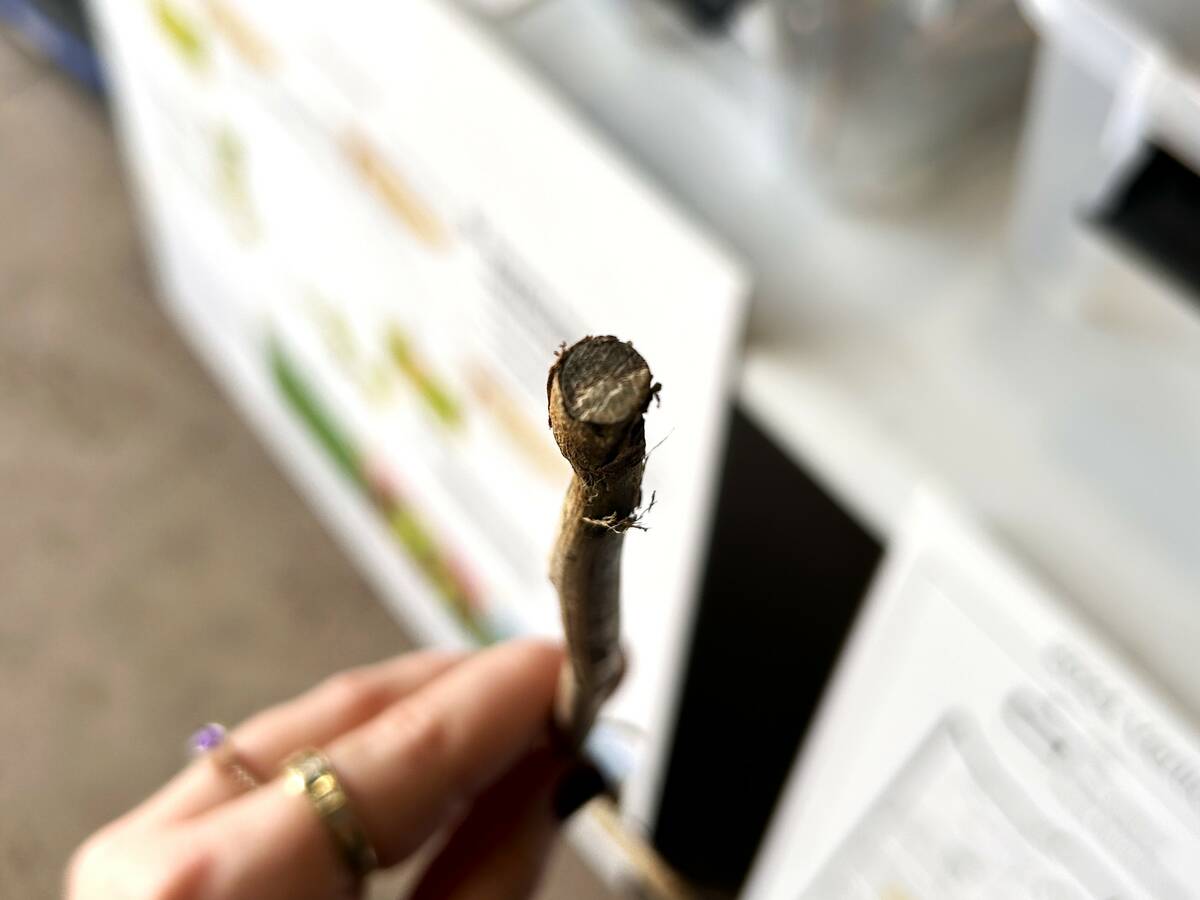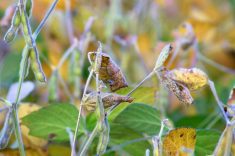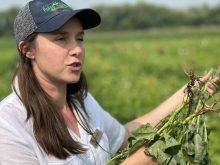There were surprises in Manitoba soybean trends this year.
While still among the top three most planted crops in the province, soybean acres are struggling to recapture the peaks of the late 2010s. In 2017, 2.29 million acres of soybeans were planted in Manitoba. Since 2020, acreage has ranged from as low as 1.34 million in 2022 to just shy of 1.6 million last year.
This year, acreage slipped again.
Read Also

Manitoba canola embattled by verticillium
Verticillium stripe pressure has been growing in Manitoba, and canola farmers still have precious few tools to protect their crop from the disease.
“We’re looking at just over 1.2 million acres,” said Manitoba Agriculture pulse and soybean specialist Dennis Lange during a Sept. 11 Crop Talk webinar. “That was a little surprising. I thought it might be a little bit higher. I think initial reports were going to be somewhere around 1.5 million acres.”
Why it matters: Soybeans are a major crop for Manitoba, but herbicide resistant weeds are adding new pressures.
Soybean variety choices also changed. Round Up Ready 2 Xtend soybeans are taking more market share, according to seeded acreage reports from the Manitoba Agricultural Services Corporation. All five of Manitoba’s top soybean varieties were loaded with the technology.
That’s a shift from just two years ago, when Syngenta’s Round Up Ready S007-Y4 was dominant, accounting for 12.3 per cent of acres, double the second-most planted variety. This year, that variety was the sixth-most planted soybean, with 5.1 per cent of acres.
Xtend varieties like S007-A2xS (also from Syngenta) and Pioneer’s P006A37X have been creeping up the list, while Bayer’s Dekalb DKB006-80 — new on the market last year — became the most planted soybean variety in Manitoba this year, accounting for 10 per cent of acres insured under MASC. Xtend varieties add dicamba to producers’ list of herbicide options.
“I think part of that could be just from all the discussions about waterhemp and other weed resistance that we’ve been dealing with,” Lange said.
Waterhemp is a growing threat in Manitoba, and is infamous for developing herbicide resistance. Last year, it was found in 20 municipalities, and more were added this year, according to provincial weed experts.
Lange also expressed surprise that S007-A2XS, a longer season variety, climbed to the second spot, accounting for 7.3 per cent of seeded soybean acres.

Dry beans
In the dry bean sector, 2024 saw a record number of pinto beans. More than 111,000 acres were planted in Manitoba. Navy beans, which once held a significant share of the edible bean market, dropped to just over 11,000 acres.
Varieties like Vibrant and Windbreaker now dominate the pinto category, making up a combined 76.1 per cent of insured acres.
Manitoba’s 48,000 acres of black beans are dominated by CDC Blackstrap and CDC Eclipse, each of which hold just shy of 40 per cent of the province’s black bean acreage.
Keeping it separate
Contamination risks between soybeans and dry beans remain top of mind for edible bean growers. Soybeans are considered an allergen, and contamination can cause problems when it’s time to sell.
“Buyers don’t like it and, in some instances, even as much as a half a per cent (in a sample), the buyers might end up rejecting that load,” Lange said.
He recommended harvesting dry beans first, since it’s difficult to sufficiently clean a combine after harvesting soybeans.
Effective harvest management for dry beans is crucial to avoid contamination and damage, Lange said. Green plant material or soil entering the combine can allow soil to stick to the seed.
“Probably the best recommendation I can give you, if you’re into dry bean production, is (to) have one of these slotted screens installed under your feeder house that will allow you to keep that soil from coming into the combine.”
He also recommended using wide wire concaves with slow cylinder speeds (300-400 rpm) to minimize soil and debris while combining. Flex headers and air bars can improve cleaning efficiency by preventing buildup and ensuring more beans are harvested.

Growing challenges
Soybeans and dry beans had issues with excess moisture and wind damage, particularly those planted in the lighter soils growers normally target for those crops.
“Some of these soybeans and dry bean fields got hammered multiple times with heavy winds … and (it) really beat up those plants,” Lange said.
The soybeans rallied but took more time to grow, and some fields were replanted.
Iron deficiency chlorosis (IDC) remains a key issue for soybeans, especially in areas with high carbonates and salts. A variety trial near Winnipeg assessed various soybean varieties for the problem.
“One of the things you should note when you’re in the combine is … if you’re seeing any of these short plants at this stage of the game … that’s usually kind of remnants of the IDC that you’ve seen earlier in the season.”
Soil tests for carbonates and salts can help determine if IDC is the issue, and choosing a more resistant variety might be necessary in the future.
In the home stretch
At the R5 stage, soybean seeds are about an eighth of an inch long and frost can cause yield losses ranging from 50 to 70 per cent, Lange said. By the R6 stage, the seeds fill the entire cavity on the uppermost nodes of the plant and frost impact is lessened.
Risk of frost damage lessens further at the R7 stage. Yield losses are typically around five per cent. At the R8 stage, plants reach full maturity, with 95 per cent of pods turning brown and seeds rattling when shaken. Historically, frost has not been a major problem for plants nearing the R7 or R8 stages.
Lange remains wary of phytophthora root rot, a disease linked to heavy or waterlogged soils.
“We did find some phytophthora root rot again this year. We always seem to find a little bit every year, (but there was) a bit more this year in some areas.”
Signs of the disease include darkened plants from the roots up and wilted, droopy leaves.
“If you’ve seen large areas of that, you may want to look at a different variety for next year, something that might have some different resistant genes that you can work with,” he said.
He also warned producers to watch for waterhemp. It can be distinguished from other pigweeds by its leaf shape and stem colour.
“Watch for those weird-looking pigweed plants at this time of the year, especially in soybeans. Keep those things in mind. Don’t put them through the combine.”
















